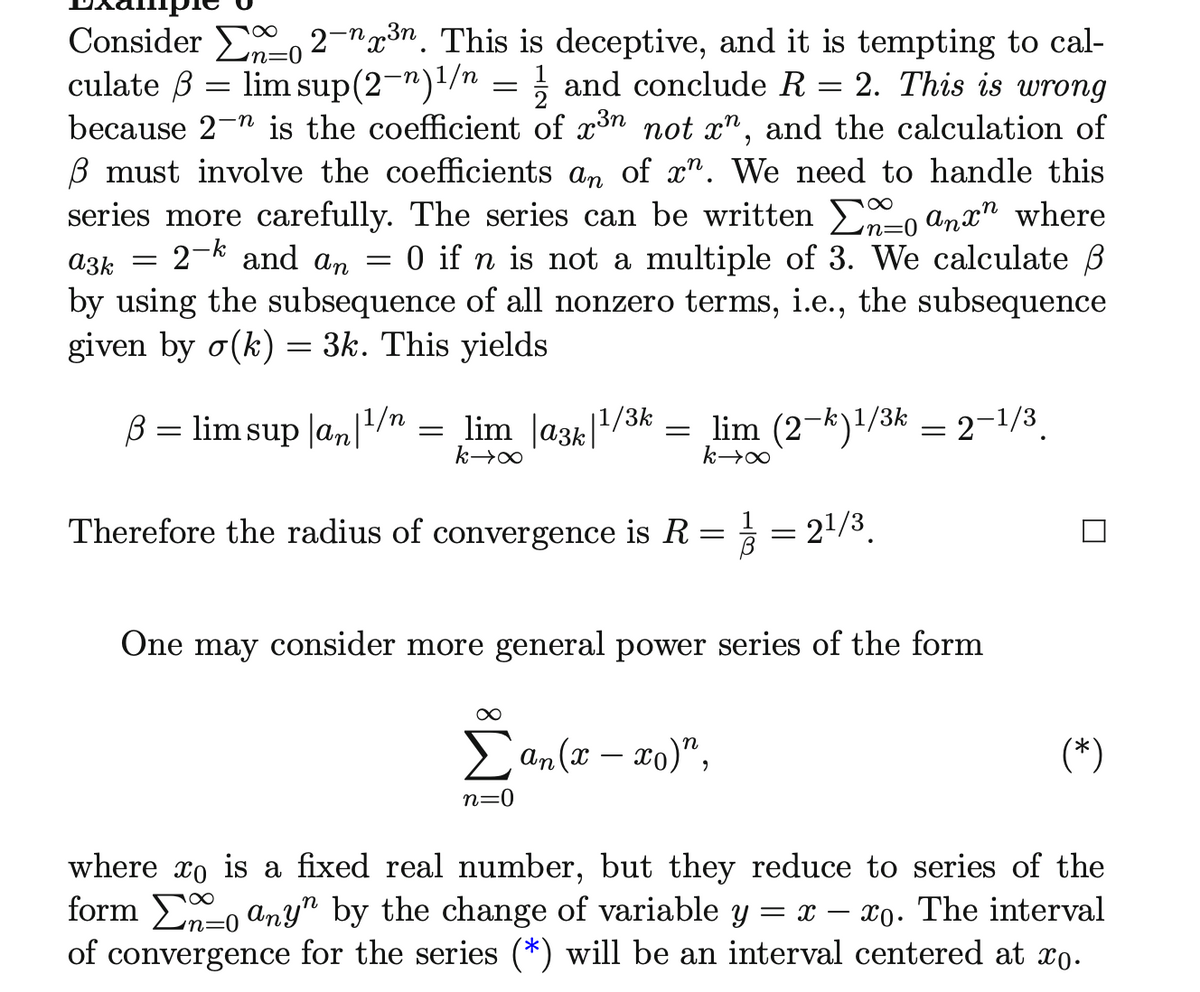Consider n=0 2-³n. This is deceptive, and it is tempting to cal- culate B lim sup(2-¹)¹/n = ½ and conclude R 2. This is wrong = n=0 because 2 is the coefficient of x³n not xn, and the calculation of ß must involve the coefficients an of xn. We need to handle this series more carefully. The series can be written Σão anxª where azk = = 0 if n is not a multiple of 3. We calculate by using the subsequence of all nonzero terms, i.e., the subsequence given by σ(k) = 3k. This yields 2-k and an = B = lim sup |an|¹/n = lim |a3k|¹/3k Therefore the radius of convergence is R = }} = 2¹/³. ∞ = = _lim (2-k)¹/³k = 2−1/3 k→∞ One may consider more general power series of the form Σan(x-xo)", n=0 (*) where to is a fixed real number but they reduce to series of the
Consider n=0 2-³n. This is deceptive, and it is tempting to cal- culate B lim sup(2-¹)¹/n = ½ and conclude R 2. This is wrong = n=0 because 2 is the coefficient of x³n not xn, and the calculation of ß must involve the coefficients an of xn. We need to handle this series more carefully. The series can be written Σão anxª where azk = = 0 if n is not a multiple of 3. We calculate by using the subsequence of all nonzero terms, i.e., the subsequence given by σ(k) = 3k. This yields 2-k and an = B = lim sup |an|¹/n = lim |a3k|¹/3k Therefore the radius of convergence is R = }} = 2¹/³. ∞ = = _lim (2-k)¹/³k = 2−1/3 k→∞ One may consider more general power series of the form Σan(x-xo)", n=0 (*) where to is a fixed real number but they reduce to series of the
Chapter9: Sequences, Probability And Counting Theory
Section9.4: Series And Their Notations
Problem 10TI: Determine whether the sum of the infinite series is defined. 24+(12)+6+(3)+
Related questions
Question
find the exact interval of convergence of the below:

Transcribed Image Text:in=0
·n
Consider 2-³n. This is deceptive, and it is tempting to cal-
culate 3 = lim sup(2-2)1/n = and conclude R = 2. This is wrong
because 2 is the coefficient of x³n not xn, and the calculation of
B must involve the coefficients an of x^. We need to handle this
series more carefully. The series can be written 0 anx" where
= 2-k and an =
= 0 if n is not a multiple of 3. We calculate B
by using the subsequence of all nonzero terms, i.e., the subsequence
given by a(k)= 3k. This yields
азк
=
ß = lim sup |an|¹/n
=
lim |a3k|¹
k→∞
1/3k
=
∞
lim (2-k)1/3k 2-1/3
k→∞
Therefore the radius of convergence is R
=
1/² = 2¹/3
One may consider more general power series of the form
Σan(x - xo)",
n=0
=
U
(*)
where xo is a fixed real number, but they reduce to series of the
form o any by the change of variable y = x − xo. The interval
of convergence for the series (*) will be an interval centered at xo.
2=0
Expert Solution
This question has been solved!
Explore an expertly crafted, step-by-step solution for a thorough understanding of key concepts.
This is a popular solution!
Trending now
This is a popular solution!
Step by step
Solved in 3 steps with 3 images

Recommended textbooks for you


Algebra & Trigonometry with Analytic Geometry
Algebra
ISBN:
9781133382119
Author:
Swokowski
Publisher:
Cengage


Algebra & Trigonometry with Analytic Geometry
Algebra
ISBN:
9781133382119
Author:
Swokowski
Publisher:
Cengage